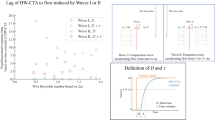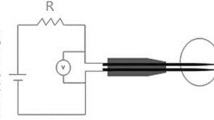Abstract
The use of hot-wire anemometry in carbon dioxide flow under supercritical conditions has been analyzed and implemented for the first time. A two-sensor probe to simultaneously measure streamwise velocity and temperature in this flow has been designed and constructed. A calibration and test flow loop that can provide supercritical state conditions above the critical point has been also designed, fabricated and tested. The temperature and velocity flow fields of the flow loop can be varied at constant pressure. It has been found that, above the pseudo-critical temperature, the velocity sensor response fits King’s cooling law with a high correlation coefficient. The dependence of the King’s law parameters on temperature can be accurately presented with second or higher order polynomial or exponential fits, depending on the extent of the temperature range. Below the pseudocritical temperature the data is scattered, and the variation with temperature of the King’s law parameters, determined from calibration, is irregular. The influence on this data scatter of the strong variation of the fluid properties near the critical point is analyzed, and a possibility to reduce it is proposed. The temperature sensor response both above and below the pseudocritical temperature is similar to the response under normal conditions. It is linear with a very high correlation coefficient between the calibration data and the fitted curve. It is also shown that the temperature response is not affected by variation of the flow’s speed.















Similar content being viewed by others
References
Arai Y, Sako T, Takebayashi Y (2002) Suprcritical fluids—molecular interactions, physical properties and new applications. Springer, Berlin Heidelberg New York
Blackwelder RF (1981) Hot-wire and hot-film anemometers, methods of experimental physics: fluid dynamics. Academic Press, New York
Cheng X, Schulenberg T (2001) heat transfer at the supercritical pressures-literature review and application to an HPLWR. Institut fur Kern und Energietechnik Programm Nukleare Sicherheitsforschung, Karslruhe
Hall WB (1971) Heat transfer near the critical point. Advance Heat Transfer, 7. Academic Press, New York
Hall WB, Jackson JD (1978) Heat transfer near critical point, Keynote lecture. In: sixth international heat transfer conference, Toronto
Jackson JD (1975) Heat transfer to supercritical pressure fluids, Part 1—summary of design Recommendation end equations, AERE-R8157
Koshizuka S, Takano N, Oka Y (1995) Numerical analysis of deterioration in heat transfer to supercritical water. Int J Heat Mass Transfer 38(16):3077–3084
Kramers H (1946) Heat transfer from spheres to flowing media. Physica 12:61–80
Krasnoshchekoc EA, Protopopov VS (1966) Experimental study of heat exchange in carbon dioxide in the supercritical range at high temperature drops. Teplofizika Visokikh Temperatur 4(3):389–398
McEligot DM (1986) Convective heat transfer in internal gas flows with temperature dependent properties. Advance Transport Process 4:113–200
Petukhov BS (1970) Heat transfer and friction in turbulent pipe flow with variable physical properties. Advance Heat Transfer, 6. Academic Press, New York
Vukoslavčević PV, Wallace JM (2002) The simultaneous measurements of velocity and temperature in heated turbulent air flow using thermal anemometry. Meas Sci Technol 13:1615–1624
Yamagata K, Nishikawa K, Hasegawa S, Fujii T, Yoshida S (1972) Forced convection heat transfer to supercritical water flowing in tubes. Int J Heat Mass Transfer 15:2575–2593
Acknowledgment
The research has been supported as part of US DOE I-NERI Project 2002-016-K.
Author information
Authors and Affiliations
Corresponding author
Rights and permissions
About this article
Cite this article
Vukoslavčević, P.V., Radulović, I.M. & Wallace, J.M. Testing of a hot- and cold-wire probe to measure simultaneously the speed and temperature in supercritical CO2 flow. Exp Fluids 39, 703–711 (2005). https://doi.org/10.1007/s00348-005-0002-z
Received:
Revised:
Accepted:
Published:
Issue Date:
DOI: https://doi.org/10.1007/s00348-005-0002-z




